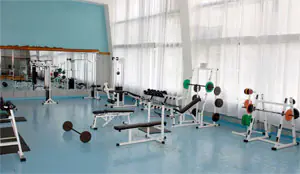Planning of physical therapy work is carried out on the basis instructive and methodological recommendations and is entrusted to a physical therapy doctor, methodological instructor or physical therapy instructor with a minimum of secondary education. Depending on the focus, profile and capabilities of a medical institution or sanatorium and sports organization (hospital, clinic, rehabilitation center, sanatorium), departments or exercise therapy rooms are created.
The physical therapy doctor carries out direct management and control over the use of exercise therapy in this institution, conducts special examinations of patients, clarifies indications and contraindications for prescribing exercise therapy, determines the form, methodology and dosage of physical activity, evaluates the effectiveness of procedures, monitors the work of exercise therapy instructors and directly conducts exercise therapy with individual patients. The prescribed treatment is recorded by the doctor in the patient’s chart in the physical therapy room (form No. 042-u).
A physical therapy instructor, guided by a doctor’s prescription or independently, compiles sets of exercises, conducts individual and group classes, prepares sports equipment,, together with a doctor, monitors the sanitary and hygienic condition of exercise therapy venues, and carries out sanitary and educational work. He also enters the data of anthropometric measurements and functional tests into the map, conducts accounting of issued procedures, the patients' reactions to the exposure are recorded. The nurse helps the instructor in preparing the room (ventilation, placement of equipment), registers patients’ attendance in the office or physical therapy room, and conducts classes in hygienic gymnastics. All work carried out in the exercise therapy department (office) is recorded daily in the doctor’s and instructor’s work diaries, and monthly, quarterly and annual reports on the work done are also compiled.
The choice of location for the lesson depends, first of all, on the patient’s condition. Training in therapeutic physical culture can be carried out in wards, specially equipped rooms and halls, as well as outdoors - in the fresh air. The exercise therapy room is designed for conducting classes with small groups (5-6 people) and individual ones. Its area is determined at the rate of at least 4 m2 for each student, but not less than 20 m2. The office must have sufficient lighting and ventilation; so that the air temperature is 18-20° C. The physical therapy room is used for both personal (individual) and group classes. It should be 60-100 m2 in area2 and have auxiliary premises: locker rooms, showers, a rest room for patients, offices for doctors and instructors. The physical therapy department also includes rooms (halls) for mechanotherapy, ergotherapy (in the absence of a specialized department), a gym, and a swimming pool for therapeutic swimming.
Exercise therapy rooms and rooms are equipped with appropriate fitness, bodybuilding and other sports equipment: mirrors, gymnastic benches, wall bars, gymnastic sticks, rings, clubs, medicine balls, volleyballs and basketballs, expanders, devices for mechanical therapy, bicycle ergometers and various exercise machines. Exercise therapy departments (offices) must have scales, a stadiometer, a spirometer, a dynamometer, a measuring tape, a protractor, stopwatches, a tape recorder, a device for measuring blood pressure and other accessories, as well as a first aid kit for emergency first aid.
To conduct classes outdoors apply equipped sites for games, special paths for measured walking and running with the obligatory presence of benches for rest, health paths, water and ski stations, etc. This option for conducting classes is the most common in a sanatorium.
Special hygienic requirements apply to patient equipment during a physical therapy session. His clothes should be as loose as possible, not restrict movement, have good hygroscopicity, breathability, and correspond to the season and weather conditions. Shoes should be light, comfortable, well-cushioned.
Post Views: 84


